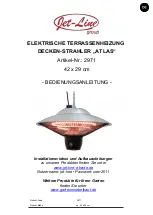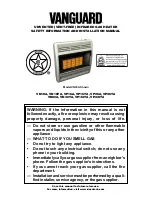
10
SNA-Series Tankless Heater
Installation
10/17/2014
Keltech •
215-1815 Rev. B; ECN 130011
Perform Operational Test No. 1
A
Ensure the enclosure door is closed .
B
Set the 3-pole switch or circuit breaker to the
ON Position .
C
Pull out the Emergency Stop Button, heater will
automatically perform a 6 second discharge
from the TepidGuard overshoot purge system .
Wait for purge cycle to complete .
E
Test water temperature and stability at
outlet by viewing the display . Controller
displays (in red) the temperature of water
exiting the heater .
F
Deactivate the shower or eyewash . The
flow sensor will electrically open contacts
and remove power from the elements and
controller so that the display is blank and
bank lights are off . Power light stays on .
D
When flow rate reaches approximately
1 .5gpm, the flow sensor recognizes this
condition and begins the heating process .
When the flow sensor activates:
• Green bank energized lights illuminate on the
front bezel verifying power supply connection to
the heating elements via the solid-state relays .
• Element load lights may be solid or flash
in unison as heating elements modulate
depending on the hot water demand .
• Digital temperature controller shows water
temperature . Additional programming is
not necessary .
Located on the panel are 1 (36-63kW) or
2 (72kW-144kW) green ready lights. When
illuminated, the safety circuit is engaged
and ready for use.
Heaters installed in pump-and-well supplied
water systems may require an operating
pressure adjustment to a differential pressure
of approximately 10 psi. For example, if the
high limit pressure is 40 psi, adjust the low
limit pressure to 30 psi with the pressure
switch located on the supply pump.
Heater will not energize heating elements if the
inlet water temperature is equal to or greater than
the temperature set on the digital controller .
If the water flow exceeds maximum heating capacity of the heater, the temperature of water at the
outlet may be lower than the temperature selected on the controller. See Table 3 to determine maximum
temperature rise capabilities.
Maximum Temperature Rise (GPM & °F)
Low Flow Activation* (1.5gpm)
High Flow Activation*(15 gpm)
Models
480/600V
kW Low/
High
2 .5 gpm
Δ
T °F
3 gpm
Δ
T °F
5 gpm
Δ
T °F
8 gpm
Δ
T °F
15gpm
Δ
T °F
20gpm
Δ
T °F
25 gpm
Δ
T °F
30gpm
Δ
T °F
35gpm
Δ
T °F
40 gpm
Δ
T °F
45gpm
Δ
T °F
50gpm
Δ
T °F
SNA-363
12/36
33
27
16
10
16
12
10
SNA-543
18/54
49
41
25
15
25
18
15
12
10
SNA-633
24/63
57
57
29
20
29
22
17
15
12
SNA-723
27/72
73
61
37
23
32
24
19
16
14
10
SNA-1083 40/108
109
90
54
34
49
36
29
24
21
18
16
14
SNA-1263 47/126
128
106
64
40
57
43
34
28
24
21
19
17
SNA-1443 54/144
147
122
73
46
65
49
39
33
28
24
21
19
Maximum Temperature Rise (LPM & °C)
Low Flow Activation* (1.5gpm)
High Flow Activation*(15 gpm)
Models
480/600V
kW Low/
High
9 .5 lpm
Δ
T °C
11 .3 lpm
Δ
T °C
18 .9 lpm
Δ
T °C
30 .3 lpm
Δ
T °C
56 .7 lpm
Δ
T °C
75 .6 lpm
Δ
T °C
94 .5 lpm
Δ
T °C
113 .4 lpm
Δ
T °C
132 .5 lpm
Δ
T °C
151 lpm
Δ
T °C
170 .3lpm
Δ
T °C
189 .3lpm
Δ
T °C
SNA-363
12/36
18
15
9
6
9
7
6
SNA-543
18/54
27
23
10
8
14
10
8
7
6
SNA-633
24/63
32
32
16
11
16
12
9
8
7
SNA-723
27/72
40
34
21
13
18
13
11
9
8
6
SNA-1083 40/108
60
50
30
19
27
20
16
13
12
10
9
8
SNA-1263 47/126
71
59
36
22
32
24
19
16
13
21
11
9
SNA-1443 54/144
82
68
41
26
36
27
22
18
16
13
21
11
TABLE 3
…continued on next page



































